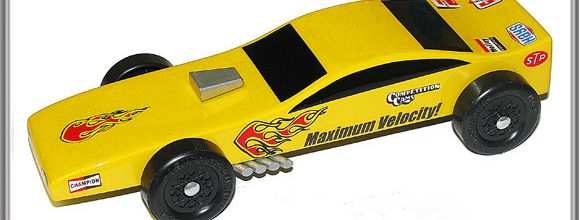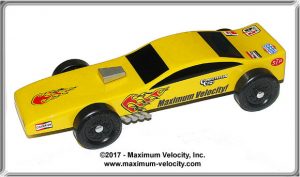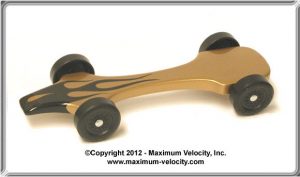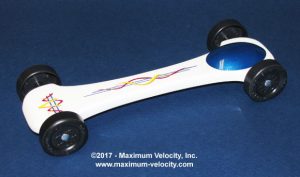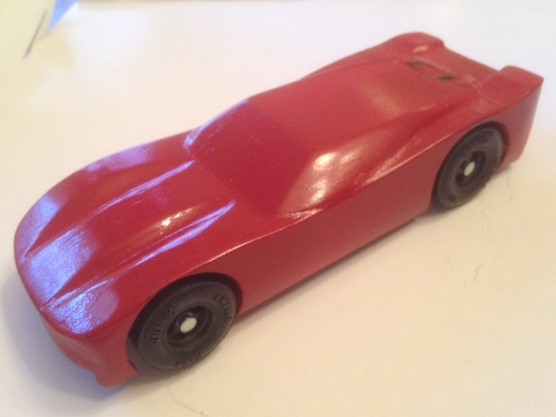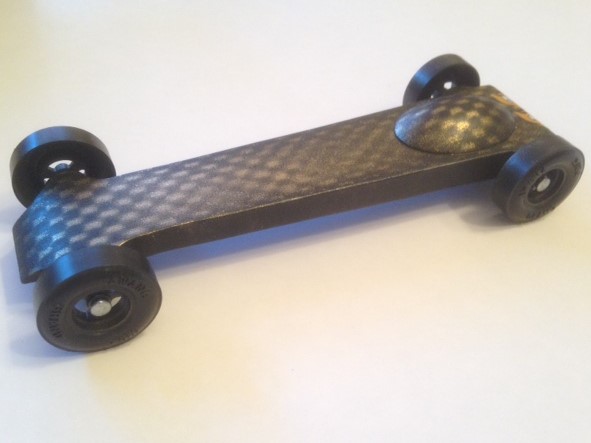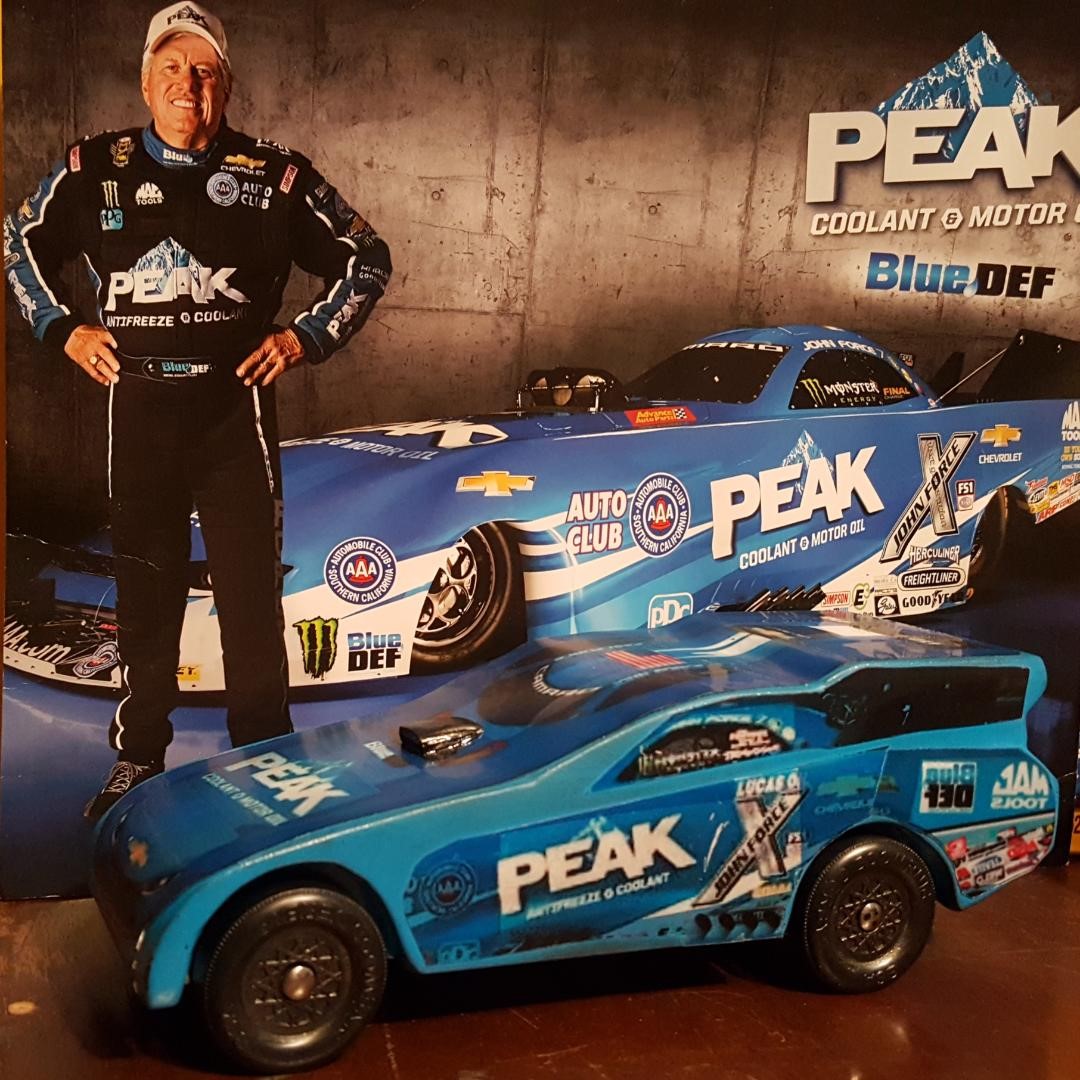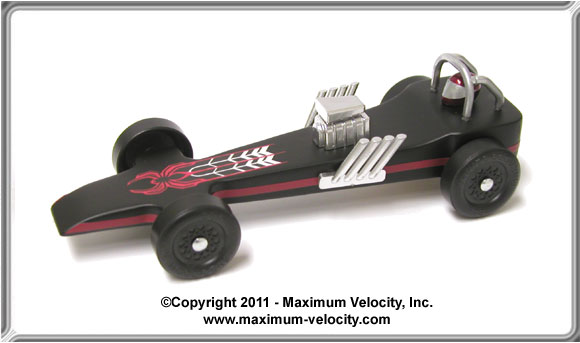In this Edition:
– Editor’s Notes
– Feature Article: Five Keys to Performance
– Humor
– Product Showcase: Fall Sale – 10% Off
– Pinewood Derby Car Showcase
– Pinewood Derby Memory: Keep it Inside – It’s Cool inside
– Q&A
Editor’s Notes
Welcome to the New Pinewood Derby Season
It’s autumn, and time for the new pinewood derby season again. We’re looking forward to a super race season, and we hope you are too. Here at Maximum Velocity we have developed some great new products to help you be successful in your upcoming races, and we have a new web site.
We have a full agenda of articles and photos to educate, entertain, and (hopefully) inspire you. But we are always looking for your input. So, please send us your photos, speed tips, articles, memories, etc.
New Web Site
We spent most of the summer working on our new web site. It is quite a change from the previous site and will take a bit of getting used to (for us as well). Unfortunately, our old site had outlived its usefulness, as it was based on old technology and could not easily be changed to meet new Internet requirements.
If you have questions or issues with the new site, please let us know. Thanks.
New Products for the 2018-19 Season
We have a few exciting new products to help you reach Maximum Velocity:
New Plan Booklet: Car Plans 10 is now available with plans for the Funny Car, the Low-Rider GT, and the Dominator design.
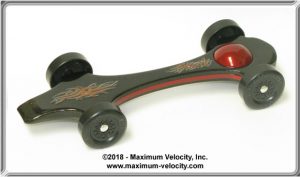
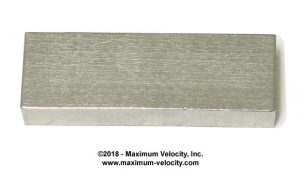
Inventory Clearance Sale
We are clearing inventory on several items including:
– Tungsten & Tundra Weights
– Formula One, Barracuda, and Vector car kits
We don’t have many remaining, so don’t delay.
Can We Help?
If we can help you in any way with your pinewood derby project, or if you have any feedback regarding this newsletter, please Contact Us.
Feature Article
Five Keys to Performance
By Randy Davis
(This article was last published in 2015, but I wanted to make a few changes and run it again.)
I can’t count how many times I have been asked, “What is your fastest car design?” If you have been involved in pinewood derby racing for any time at all, or if you have been a subscriber to this newsletter, then you understand that there is no car body that guarantees success. There are lots of factors that affect speed, and the car body accounts for only a few of those factors. I try to explain this, but the inquirer usually just sloughs off that answer and repeats the question.
Today I would like to go through the main factors that affect speed; and since, as a subscriber to the Pinewood Derby Times you are astute and thoughtful, I know that you won’t just slough off this information! So, let’s go through the five keys that unlock the performance of a pinewood derby car. I have arranged the keys in order of importance.
Key 1: Lubrication – Quality lubricant; applied properly
Lubrication is an extremely important key. The difference in time between a well-lubricated car and a car without lubrication can be several tenths of a second or more (this translates into several feet on the track).
Most people use graphite for lubrication. Graphite is a form of carbon that comes in very small flakes. There are many varieties and qualities of graphite available at hobby and hardware stores, so make sure to get a good brand. Cheap brands have a lower carbon content and include impurities. We offer Max-V-Lube brand which is a high-purity graphite, which has been proven to produce top results in pinewood derby racing.
When lubricating with graphite, take the time to work it in thoroughly; a casual puff before the race is not sufficient. I recommend spending five minutes per wheel adding graphite, spinning the wheel, adding graphite, spinning the wheel etc. Since graphite works best after a break-in period, don’t re-lubricate between race heats. By the way, you will find it much easier and cleaner to lubricate before mounting the wheels and axles on the car.
If you use a liquid lube (such as Krytox 100), make sure to follow the recommended application procedure. With liquid lubes, less is best.
Key 2: Wheel Axle Preparation – Axles – no flaws, straight, polished; Wheels – no flaws, polished
All frictional losses in a pinewood derby car come from the wheels and axles. Start by inspecting the parts in your kit to make sure they are usable. If a part has a serious flaw, replace it.
Next, prepare the nails.
- Place the nail in the chuck of a drill and use a Mini-File to remove the flashing under the nail head and minimize the ridges on the shaft. Beveling the nail head slightly is also a good idea. (If you are in a race using Awana or Maximum Velocity kits, the mini-file is not needed).
- Optionally use the Pro-Axle Press to ensure that the nails are straight and round.
- Finally, polish the axles with an Axle Polishing Kit until they are bright and shiny. Avoid overzealous sanding with coarser papers, as that will reduce the diameter of the axle (not desirable).
Depending on the type of wheels you have, the preparation steps will change. If there are flaws on the tread surface or inside edge of the wheel, then use a Pro-Wheel Mandrel and some fine grit (wet) sandpaper to polish the wheels. On some wheels, a Pro-Hub Tool can be used to round the inside wheel hub. Finally, polishing and waxing the wheel bore also reduces friction to increase performance.
Key 3: Alignment – Car goes straight, or rail-rides
In order for the car to get to the finish line as quickly as possible, it needs to go straight. If it zigzags down the track, it will travel a longer distance, but worse it will continually lose speed as it bumps and rubs against the guide rail.
To minimize the amount of alignment adjustment needed, make sure that the axle slots/holes are perfectly parallel to each other and the axles are straight. Also, when using axle slots, make sure that the axles are inserted perfectly straight. The Pro-Axle Press and the Pro-Body Tool are great tools to help minimize the need to align the wheels. In addition, the Pro-Axle Guide will help you insert the wheels and axles properly.
The current thought on alignment is to implement a rail-riding strategy.(1) This technique results in a car that follows the rail (straightest path to the finish line), minimizes undesirable wheel contact with the rail, and allows for more aggressive rear weighting.
Normally, with rail-riding, the two rear axles are bent upwards at 2.5 degrees, the front-left axle is raised, and the front-right axle (the “dominant” or steering axle) is bent downwards at 1.5 degrees. The rear wheels are aligned to have no toe-in or toe-out, and the dominant axle is aligned so that the car drifts left about five inches over eight feet.
If you don’t want to try rail-riding, then make sure your car runs as straight as possible.
Key 4: Maximize Momentum – Maximum weight; Weight towards the rear of the car
In an automobile, momentum helps the car keep rolling when you take your foot off the gas. In a similar way, momentum helps a pinewood derby car to continue rolling as fast as possible on the flat section of the track. Momentum must be maximized for top performance, and the key to momentum is weight. In each race, there is a maximum allowable weight for the car (usually five ounces, but certainly check your local rules). Momentum is maximized when your car has the maximum allowable weight for your race.
For a five-ounce maximum weight, you will likely need to add two or three ounces of weight to the car. But where on the car do you add the weight? Add the weight towards the rear of the car.
Tests show that best performance is achieved on most tracks when the weight is added towards the rear of the car. This can be overdone, but a simple test to make sure the car is properly weighted is to balance the finished car on the edge of a ruler, or a balance stand. The car should balance somewhere between 3/4 and one inch in front of the rear axle.(2)
Does the type of weight matter? The maximum weight can be achieved with any type of weight; however, the type of weight does affect how easily the desired weight and balance point can be achieved. Denser weights (such as Lead or Tungsten) take up less space, so it is easier to reach the maximum weight and to place the weight at the back of the car. Also, since denser weights require a smaller volume of space, they allow creation of more aerodynamic cars (which is Key 5).

Key 5: Aerodynamics – Profile and body features minimized to improve air flow
If you had asked me several years ago, “How do I make my pinewood derby car go fast?” I would not have included aerodynamics as a key. However, since that time I have read one study and performed another, both of which showed that the effect of aerodynamics on pinewood derby car performance is not trivial.
There are many elaborate ways to improve aerodynamics, but to simplify matters, let’s use the following principles:
- Low-profile cars (smaller surface area as viewed from the front of the car) will tend to outperform higher-profile cars.
- Cars should taper from a smaller surface area in the front to a (possibly) larger surface area in the rear.
- Edges running across the car should be rounded or tapered.
- Wings, sails, flags, pennants, etc. add to the surface area, thus they tend to decrease performance.
- Smooth, slick paint job.
- Fenders help air to flow smoothly around the wheels. Just make sure to use light weight wood or plastic fenders.
To add some balance to this topic, Key 5 (aerodynamics) is not as important as the other four keys, so I don’t suggest that you sacrifice looks to achieve an aerodynamic shape. If your child wants to build a car that is not particularly aerodynamic, don’t worry about it. Just make sure that the other four keys are carefully followed.
Conclusion
There are many other things you can do to create a competitive pinewood derby car. If you want to read further, our booklet, “Speed to the Finish” thoroughly documents the techniques and tips needed to get top speed out of your car.
But whatever you do, just remember that to create a competitive pinewood derby car, make sure to use the Five Keys!
(1) For a thorough discussion on rail-riding, please see: “Rail-Riding – Getting that Extra Speed” in Volume 14, Issue 4.
(2) With Rail-Riding alignment, you can set the balance point closer to the rear axles. For more information, please see “Revisiting the Balance Point” in Volume 14, Issue 1.
Humor
My Mother
My Mother taught me LOGIC…”If you fall off that swing and break your neck, you can’t go to the store with me.”
My Mother taught me MEDICINE…”If you don’t stop crossing your eyes, they’re going to freeze that way.”
My Mother taught me TO THINK AHEAD…”If you don’t pass your spelling test, you’ll never get a good job!”
My Mother taught me ESP…”Put your sweater on; don’t you think that I know when you’re cold?”
My Mother taught me TO MEET A CHALLENGE…”What were you thinking? Answer me when I talk to you…Don’t talk back to me!”
My Mother taught me HUMOR…”When that lawn mower cuts off your toes, don’t come running to me.”
My Mother taught me how to BECOME AN ADULT…”If you don’t eat your vegetables, you’ll never grow up.
My mother taught me about GENETICS…”You are just like your father!”
My mother taught me about my ROOTS…”Do you think you were born in a barn?”
My mother taught me about the WISDOM of AGE…”When you get to be my age, you will understand.”
My mother taught me about ANTICIPATION…”Just wait until your father gets home.”
My mother taught me about RECEIVING…”You are going to get it when we get home.”
And, my all-time favorite – JUSTICE…”One day you’ll have kids, and I hope they turn out just like YOU — then you’ll see what it’s like!”
Product Showcase
Fall Sale – 10% Off
Through October 16, 2018, you can get 10% off your entire order. To take advantage of this limited time offer, use coupon code OCT03NL during checkout.
Pinewood Derby Car Showcase
The “Red Bomb”, styled after a Corvette, won 1st Place. It has lightened wheels and polished axles mounted in pre-drilled axle holes. Tungsten cylinder weights were centered into the rear of the car, so the center of gravity is about 1 1/2 inches forward of the rear axle. The side aprons extend down from the base of the car about 1/4 inch and were dado cut inside about 1/8 inch for rail clearance. Red Bomb won every heat and had the fastest time of the day.
California Gold – Clifford Schmidt
The “California Gold” extended wheelbase model won 3rd Place. It has lightened wheels, polished axles, extended wheelbase with pre-drilled axle holes, tungsten canopy weight with additional tungsten disks centered behind the canopy from underneath. The paint is flat black. I then covered the car with a perforated drawer mat and sprayed gold paint over it to achieve the checkered pattern. The car ran very fast along with the front runner and the second-place finisher (one that I built but gave to one of the clubbers).
I took my son to the NHRA Winternationals. John Force is a client of the company I work for, so we were excited to make a replica of his top fuel funny car.
Share Your Car with Our Readers
Do you have a car you would like to “show off” to our readers? If so, send us a photo of your car along with a description of any special features to: in**@**************ty.com
Please include your full name. If selected, we will include the photo and description in this newsletter.
Photos must be sent by e-mail in JPG format (minimum size of 640×480, maximum size of 1280 x 960). Please shoot photos from the front left of the car, similar to the orientation of car shown at:
For better focus, keep the camera four or five feet away from the car, and then use the camera’s zoom to fill the frame with the car. Also, use a solid (preferably white) background for the photo.
Send only one photo per car, unless an additional photo is needed to adequately show a feature. Also, only one car per subscriber per year please. Thanks.
Pinewood Derby Memory
Keep it Inside – It’s Cool inside
We have a car show every year at our church, Roanoke Valley Cathedral of Praise. We wanted the show to be more of a family affair by getting the kids involved. Someone suggested we set up the pinewood derby race track and have races. For those that didn’t have cars we were going to provide our cars for rent at the price of one dollar a race. We were to put numbers on our cars and when someone rented a car they would pull a number out of a hat and that would be the car they would race for one heat. We thought we had it all worked out.
I had the track and timer all set up ready to go. We decided to run a couple of cars to make sure everything worked right. When we did the timer lights would come on and go off, and the timer would only showed one lane. We worked with it for a long time and I finally called my friend who helped put the timer together and told him the problem. He asked me if we were outside and I told him yes, we had it all set up outside on the sidewalk. He told me there was too much light, and the timer wasn’t going to work correctly outside. I carried the timer inside just to see if it would work in there. Of course, it worked perfectly.
I learned the hard way to race inside – besides it’s air conditioned inside!
George Gobble
Editor’s Note – New Directions (www.newdirections.ws) offers a timer with a “sunlight option” which can be used outdoors.
Do you Remember?
If you have a pinewood derby story that is funny, unusual, sad, heart-warming, etc., please send it to me in an e-mail. Don’t worry about literary polish. We will edit as needed before publishing.
If your story is used, you will receive a $10 coupon in May of 2019.
Q&A
Q: I was wondering if you had any tips for installing Pinewood Derby axles to the car body. I drilled the holes to the recommended size (#44 bit if I remember correctly) and I own a pair of your axle pliers. But I find that the pliers have the potential to damage the outer edge of the axle head and/or the outer hub of the wheel. Obviously, this is a concern. I thought about devising a jig to hold the car from one side while I press in the axle from the other side, perhaps in a small vice. I figure the pressing force could be on the axle head, thus protecting the axle edge and wheel outer hub. Do you have any insight you could share?
A: Generally, you would use a #44 bit. When you drill wood, over time the wood fibers “relax” resulting in a smaller hole. Also, sawdust and paint can get in the holes, which tightens them up.
So, before installing axles, ream out the holes with the same drill bit (you can use a Pin Vise for this). That opens up the holes, cleans out any sawdust or paint, and thus allows the axles to go in easier.
Another tip is to pre-install and remove a set of spare axles right after drilling the holes. Then use spare axles or round toothpicks (or a Paint Stand) when painting to keep paint out of the holes.
Q: Here’s the problem … for the 2nd year in a row, we have gone to a local fitness center and tuned our cars on a treadmill just as a YouTube video explains. In both cases, the cars appeared to behave very nicely on the treadmill, tracking steadily in the correct direction as the video explains; i.e., towards the high wheel with the rear wheels holding steady against the nail head.
But when we run the cars down the racetrack, we notice significant fishtailing. This has me very baffled knowing they behaved nicely on the treadmill. Of course, I am trying to figure out how to eliminate fishtailing so we don’t lose performance. I’m not sure I have much faith in the treadmill idea anymore. Do you know any alternative suggestions for tuning the wheels and axles?
A: The fishtailing is either because there was not enough drift, or the rear axles were not aligned. I suggest ditching the tread mill method (which has a lot of problems that I won’t go into here), and follow the method shown in the main article.
The article says you need 5 inches of drift over 8 feet. This is good for a COG of 3/4 inch. But if your COG is less than that, you will need more drift. The rule is, the more aggressive the COG, the more drift you need.
Want Answers?
Do you have a pinewood derby-related question? If so, e-mail us your question.We answer all questions by e-mail, but not every question will appear in the Q&A section of the newsletter.
Back Issues
Are you a new subscriber, or have you missed some of the previous newsletters? Don’t miss out; all of the issues for Volume 5 through Volume 18 are posted on our web site.
Newsletter Contributions
We welcome your contributions. If you would like to contribute an article, a web site review, a speed tip, or a pinewood derby memory, please e-mail us.
Subscription Information
The Pinewood Derby Times is a free e-newsletter focused on pinewood derby racing. It is published biweekly from October through March.
If you haven’t already done so, please forward this issue to your pinewood derby friends. But please don’t subscribe your friends. Let them decide for themselves. Thanks.
If this newsletter was forwarded to you, why not subscribe to receive this newsletter. There is no cost, and your e-mail address is safe, as we never sell or share our distribution list.
To subscribe, send a blank e-mail to
pi*********************@*******st.com
You will receive a confirmation e-mail. Reply to the confirmation e-mail and you will start receiving the Pinewood Derby Times with the next issue.
Randy Davis, Editor, Pinewood Derby Times
E-Mail: in**@**************ty.com
(C)2018, Maximum Velocity, Inc. All rights reserved. Please do not reprint or place this newsletter on your web site without explicit permission. However, if you like this newsletter we grant permission, and encourage you to e-mail it to a friend.
Maximum Velocity disclaims any personal loss or liability caused by utilization of any information presented in this newsletter.
The Pinewood Derby Times is not specific to, and is not affiliated with the Boy Scouts of America, YMCA, Awana, or any other organization.
(R)Maximum Velocity is a registered trademark of Maximum Velocity, Inc.
(R)Pinewood Derby is a registered trademarks of the Boys Scouts of America.
(R)Awana is a registered trademark of Awana Clubs International.
All other names are trademarks of their respective owners.

